
Navigating the world of dermatology can be daunting, especially with treatments like fillers and neurotoxin decatur. These options offer solutions for those seeking to enhance their appearance. Fillers have become popular for adding volume and smoothing lines. They can provide natural-looking results. Understanding the role of dermatologists in this process can make a difference. This guide will break down what to know about these treatments and how they fit into skincare.
Understanding Fillers
Fillers are substances injected under the skin to restore lost volume and improve facial contours. They can be used to plump lips, enhance shallow areas, and soften facial creases. The main types include hyaluronic acid, calcium hydroxylapatite, and poly-L-lactic acid. Each type has different properties and benefits.
Why Choose a Dermatologist?
Dermatologists are trained to understand skin structure and the best techniques for administering fillers. Their expertise ensures safety and effectiveness. A skilled dermatologist can assess skin needs and recommend the most appropriate treatments. This knowledge minimizes risks and enhances outcomes.
Benefits of Fillers
- Immediate results
- Minimal downtime
- Customizable for natural appearance
Potential Risks
While fillers are generally safe, they are not without risks. Possible side effects include bruising, swelling, and infection. Choosing a qualified dermatologist reduces these risks. It’s important to discuss all concerns before treatment.
Comparison of Common Fillers
| Type | Duration | Usage |
| Hyaluronic Acid | 6-12 months | Lips, cheeks, wrinkles |
| Calcium Hydroxylapatite | 12 months | Deep wrinkles |
| Poly-L-lactic Acid | 24 months | Volume restoration |
Consultation and Preparation
Before receiving fillers, a consultation with a dermatologist is crucial. This meeting establishes treatment goals and expectations. During this time, the dermatologist examines the skin and discusses medical history. It’s also an opportunity to address questions about the procedure.
Procedure Process
The filler procedure is typically quick. It involves cleansing the skin and applying a topical anesthetic. The dermatologist then injects the filler with a fine needle. The process takes about 30-45 minutes. Some patients may experience mild discomfort.
Aftercare and Results
Post-treatment care is simple. Avoid strenuous activities and excessive sun exposure for a few days. Results are visible immediately, with full effects appearing in a week. Follow-up appointments ensure satisfaction with the results.
Long-Term Considerations
Fillers are not permanent. Maintenance treatments are necessary to sustain results. Discuss a long-term plan with the dermatologist. Understanding how fillers integrate with overall skincare helps in maintaining a youthful appearance.
Conclusion
Fillers offer a non-surgical option to enhance facial features and combat signs of aging. Choosing the right dermatologist is key to achieving the desired results. For more detailed information, visit trusted resources like the FDA or the American Academy of Dermatology.
With proper guidance and care, fillers can be a valuable part of a skincare routine. This understanding empowers informed decisions, leading to better outcomes and satisfaction.


